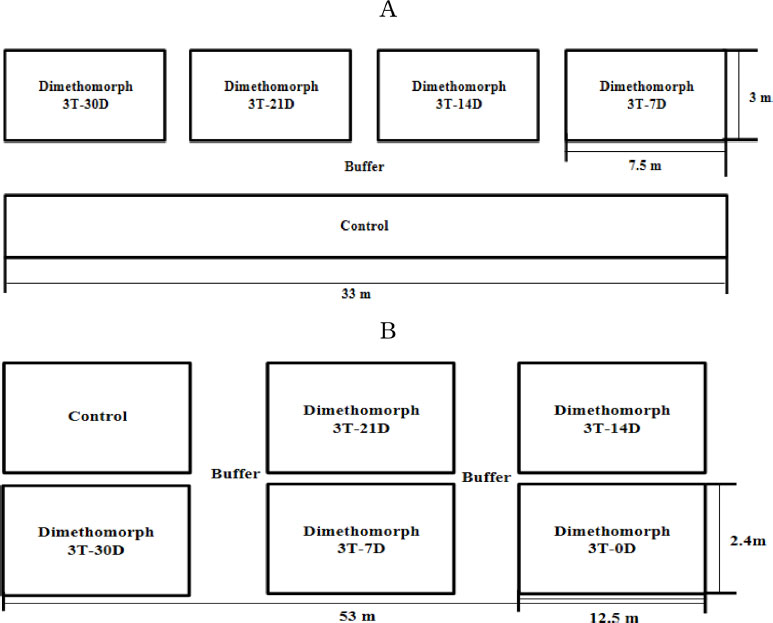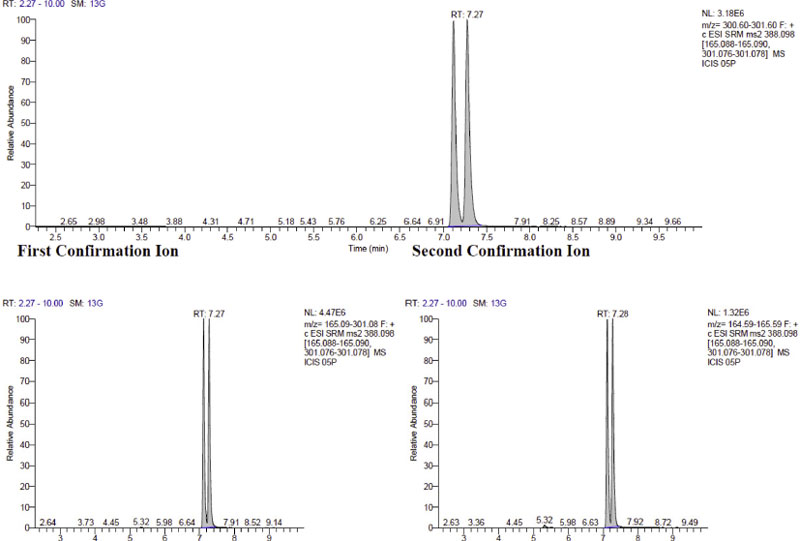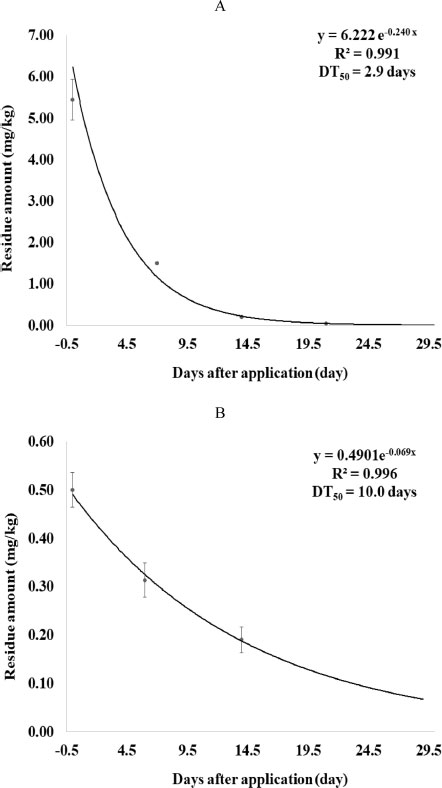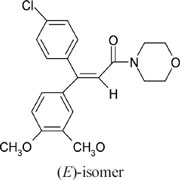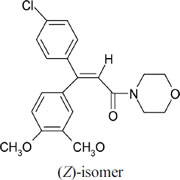
퀴노아(Chenopodium quinoa Willd.) 및 팥(Vigna anagularis Willd.) 중 살균제 dimethomorph의 잔류특성 및 안전성 평가
초록
본 연구는 소면적 재배작물인 퀴노아 및 팥 노지 조건에서 처리된 살균제dimethomorph에 대한 잔류특성 및 안전성 평가를 위해 수행되었다. 퀴노아는 수확 전 30, 21, 14, 7일 팥은 29, 21, 14, 6, 0일에 3회 경엽처리 하였으며, 최종 약제 처리 후 일시 수확하였다. 퀴노아 및 팥에 대한 잔류농약 시험방법은 QuEChERS 전처리와 LC-MS/MS를 이용하였으며, 회수율 89.1~109.0%, 변이계수 1.8~7.3%, 정량한계 0.01 mg kg-1로 시험방법의 적합성을 판단하였다. 퀴노아와 팥 중 dimethomorph의 잔류량은 각각 <0.01-3.64 mg kg-1, <0.01-0.53 mg kg-1으로 산출되었다. 위해성 평가는 일일식이섭취허용량(ADI)으로 평가하였으며, 퀴노아는 설정된 잔류허용기준인 3.0 mg kg-1, 팥은 최고잔류량을 이용하여 산출하였다. %ADI 13.2%로 %ADI 80%를 초과하지 않아 위해도는 낮을 것으로 사료된다. 본 연구는 퀴노아와 팥의 잔류특성을 구명하여 유사 작물 간의 작물 잔류성을 예측할 수 있는 기초자료로 사용될 수 있을 것으로 기대된다.
Abstract
This study was conducted to evaluate the residual characteristics and safety assessment of fungicide dimethomorph in quinoa and red beans under open field conditions. The test compound dimethomorph was sprayed three times with 7 days intervals to both crops. Quinoa samples were harvested at 30, 21, 14, and 7 days after treatment, while red b eans were harvested at 29, 21, 14, 6 and 0 days after treatment. The residues of dimethomorph were extracted by QuEChERs method and analyzed with LC-MS/MS. The recovery of dimethomorph at fortification levels of 0.1 and 0.5 mg kg-1 were ranged from 89.1 to 109.0% with a relative standard deviation <10%. The method limit of quantification was 0.01 mg kg-1. The residues of dimethomorph in quinoa and red beans found to be <0.01 to 3.64 mg kg-1 and <0.01 to 0.53 mg kg-1, respectively. The acceptable daily intake (ADI) of dimethomorph was used to calculate the safety assessment and it was calculated using the established MRL of 3.0 mg kg-1 for quinoa and the maximum residual amount in red beans. Then the result indicated that the sum of %ADI was 13.2% in both crops. It is considered that the risk is relatively low when the sum of %ADI does not exceed 80%. The result of this study is expected to be used as basic data for evaluating the residual characteristics and safety of pesticides in similar crops.
Keywords:
Dimethomorph, Quinoa, Red bean, Residue analysis, Safety uses키워드:
퀴노아, 팥, 잔류분석, 안정성 평가서 론
우리나라의 대표적인 잡곡인 조·팥·수수·피·메밀·기장 등은 식용 및 사료로 이용되며 최근에는 이들 농산물에 포함된 다양한 생리활성물질이 항산화 효과, 당뇨 및 고혈압 예방 등에 효과가 인정되면서 기능성 식품 원료로 주목받고 있다(Jang et al., 2012). 이러한 국내 식품의 트랜드에 따라 웰빙식품, 기능성 식품에 대한 소비자의 선호도가 높아지면서 국내 잡곡 소비량도 늘어남에 따라 새로운 품목에 대한 수요도 증가하고 있다(Jeong et al., 2013). 대부분 소면적 재배작물인 잡곡류는 개별 농가 및 작목반 단위로 다품종 소량 재배되어 전국규모의 소비자들에게 유통, 판매되고 있다. 한편 이들 잡곡류는 이듬해 종자로도 사용되기 때문에 수확기 수량에 큰 영향을 미쳐 초기 관리가 매우 중요하여 기능성 종실 생산이 가능한 잡곡류에서는 병해충 방제가 필수적이다(Kim et al., 2010; Jung et al., 2019). 그러나 안정적인 수량 확보와 병해충 방제를 위한 체계적인 연구가 부족한 실정이다(Park et al., 2017).
잡곡인 퀴노아(Quinoa, Chenopodium quinoa Willd.)는 명아주과 식물로 지방, 비타민, 무기질이 풍부하며, 퀴노아의 주 생산지인 남미 에콰도르에서는 퀴노아에 노균병이 빈번하게 발생하는 것으로 보고되고 있다(Jarvis et al., 2007). 또한 팥(Redbean, Vigna anagularis Willd.)은 콩과 일년생 작물로 생리활성성분을 함유하고 있으며 건강식품 및 화장품 등 다양한 용도로 사용되고 있다(Sung et al., 2020). 팥은 입모에서부터 수확기까지 전 생육기에 걸쳐 병해충이 발생하고, 수량과 품질에 영향을 미치는데 파밤나방, 탄저병, 녹병, 흰가루병, 노균병 등이 팥에 발생하는 대표적인 병해충으로 보고되고 있다(Jung et al., 2009; RDA, 2022). 따라서 퀴노아와 팥에서 주로 발병되는 노균병에 대한 병해충 방제 및 농산물 잔류농약 안전성에 관한 연구가 필요하다.
퀴노아와 팥에 발병하는 노균병은 pernospora과에 속하는 순활물기생균으로 20°C 전후의 기온에 주로 발생하며, 특히 장마철에 발병률이 매우 높고 병든 잎에서 분생포자를 형성해 공기로 전염된다(Kim et al., 2016). 또한 병 진전이 빨라 예방적 방제가 중요한 것으로 알려져 화학적 방제가 필수적으로 요구된다.
Dimethomorph는 (E)-isomer와 (Z)-isomer의 두 개의 이성질체로 구성된 carboxylic acid amide (CAA)계 살균제로 난균류의 방제에 큰 효과가 있다고 보고되어 있다(Kim et al., 2014). 이 약제는 식물 병원균의 생합성 저해제로 세포벽 형성을 저해하거나 세포벽 파괴로 약효를 발휘하는 침투 이행성이 우수한 약제로 알려져 있다(Park et al., 2012). 2022년 기준 국내에는 dimethomorph는 90여 개의 농작물에 등록되어 있으며, 노균병, 역병, 탄저병 등 다양한 병해를 방제하는 약제로 사용되고 있다(RDA, 2022).
따라서 이 연구는 퀴노아와 팥에 발생하는 노균병 방제를 위하여 사용되는 살균제 dimethomorph에 대한 포장 잔류시험을 통해 농약안전사용기준을 제안하고 잔류농약의 안전성을 평가하기 위하여 수행되었다.
재료 및 방법
시험대상
시험작물은 퀴노아(Quinoa, Chenopodium quinoa Willd., 품종: 화이트퀴노아) 및 팥(Redbean, Vigna anagularis Willd., 품종: 충주팥)을 선정하였다. 잔류성 구명을 위해 사용된 시험약제는 퀴노아 포장에 dimethomorph+pyraclostrobin 25.6(16+9.5)% 액상수화제(상표명: 캐스팅, ㈜동방아그로), 팥포장에 dimethomorph 25% 수화제(상표명: 에이스, ㈜팜한농) 제품을 구입하여 사용하였다. 약제처리를 위한 포장시험은 강원도 홍천 내촌면에 위치한 노지재배 포장을 임대하여 2018년 5월~9월까지 수행되었다.
시험구 설정 및 약제 살포
퀴노아 포장의 처리구는 대조구 33m2 (33m× 1m) 및 시험구 7.5m2 (7.5m × 1m), 팥 포장의 경우 시험구와 대조구를 동일하게 30m2 (12.5m× 2.4m)로 처리구별 3반복 배치하였으며, 약제의 비산으로 인한 교차오염을 방지하기 위해 각 처리구 사이에 1m의 완충구를 배치하였다(Fig. 1). 퀴노아는 dimethomorph+pyraclostrobin 25.5(16+.9.5)% 액상수화제 2,000배 희석액을 수확 30, 21, 14, 7일전 3회 살포하였으며, 팥은 dimethomorph 25% 수화제 1,000배 희석액을 수확 29, 21, 14, 6일전 및 수확 당일에 3회 살포하였다(Table 1). 시료는 처리구 및 반복구별 1 kg 이상을 채취하여 즉시 실험실로 운반하였으며, 수확 당일 처리구의 경우 약제 살포 후 2시간이 지나 약액이 완전히 마른 후에 채취하였다. 처리구별 수확된 시료는 드라이아이스와 함께 분쇄하였으며, 50 mL 원심분리 튜브에 10 g씩 담아 –20°C에서 냉동보관하였다.
표준물질 및 시약
퀴노아 및 팥 중 잔류농약 분석에 사용된 dimethomorph(순도 99.1%) 표준물질은 AB Solution Co., Ltd. (Hwaseong, Korea)로부터 분양받았으며, 이화학적 특성은 Table 2와 같다(MacBean, 2012). 잔류분석용 acetonitrile (순도 99.1%), methanol (순도 99.9%), 초순수는 Merck (Darmstadt, Germany)의 high-performance liquid chromatography (HPLC) grade 제품을 사용하였으며, formic acid (≥95.0%)는 Sigma-Aldrich (Saint Louid, MO, USA) 제품을 사용하였다. 전처리용 QuEChERS extraction packet (4.0 g MgSO4, 1.0 g NaCl, 1.0 g trisodium citrate dihydrate, 0.5 g disodiumhydrogencitrate sesquihydrate, EN 15662)는 Phenomenex (Torrance, CA, USA)로부터 구입하여 사용하였다.
표준용액 조제
Dimethomorph 표준품(순도 99.1%) 100.90 mg를 취해 100 mL 용량플라스크에 넣고, acetonitrile에 녹여 1,000 mg L-1 stock solution을 조제 하였다. 이를 acetonitrile을 추가 희석하여 0.01, 0.05, 0.1, 0.2, 0.5, 0.7, 1.0 mg L-1의 working solution을 조제하여 분석용 표준물질로 사용하였다. LC-MS/MS 분석용 표준물질은 무처리 시료를 이용하여 전처리된 추출물과 각각의 working solution을 1:1의 비율로 혼합하는 방식으로 matrix–matched standard를 제조한 후 분석하여 얻은 chromatogram상의 peak 면적을 이용하여 표준검량선을 작성하였다.
잔류농약 분석
분쇄된 시료 10 g에 증류수 15mL을 첨가 후 30분간 습윤화 하였으며, acetonitrile 10 mL 추가한 후 1,500 rpm으로 10분간 진탕하여 추출하였다. 추출액에 QuEChERS extraction packet (4.0 g MgSO4, 1.0 g NaCl, 1.0 g trisodium citrate dihydrate, 0.5 g disodiumhydrogencitrate sesquihydrate)을 첨가한 후 10분 동안 1,500 rpm으로 진탕 추출 진행하였으며, 추출액은 4,000 rpm으로 10분간 원심분리하였다. 이후 상등액을 취해 0.2 μm membrane filter로 여과된 추출액을 사용하였다. 분석기기 LC-MS/MS (TSQ Quantum Access Max, Thermo Fisher Scientific, San Jose, CA, USA)를 사용하여 Table 3의 조건에 따라 분석하였다. 이동상 용매는 0.1% formic acid를 포함한 초순수 및 acetonitrile을 이용하였으며, 컬럼은 CAPCELL CORE C18 (2.1 mm i.d. × 150mm L., 2.7 μm, Shiseido, Japan)을 사용하였다. 전기분무이온화(electrospray ionization, ESI)의 ion source에서 positive mode로 SRM (Selected reaction monitoring) 조건을 확립하여 분석하였다(Table 3).
회수율 분석 및 저장안전성
분석과정의 정확성 및 정밀성을 검증하기 위하여 각 작물의 회수율 시험 및 저장기간 중 dimethomorph의 안정성을 확인하기 위한 저장안정성 시험을 진행하였다. 회수율 시험은 무처리 퀴노아 및 팥 시료에 각각 정량한계의 10배, 50배 수준이 되도록 처리하여 상기의 분석방법으로 3반복 분석하였다. 분석법상 정량한계 (Method Limit of quantification, MLOQ)는 최소검출량 (Minimum Detectable Amount, MDA), 시료량, 기기 주입량 등을 이용하여 다음과 같이 산출하였다(Eq. 1). 저장안정성 시험은 무처리 시료에 1mg kg-1 1mL를 가해 냉동보관 후 상기의 분석방법으로 3반복 분석하였다.
| (1) |
안전성 평가
본 시험을 통해 산출된 잔류량으로 dimethomorph 중 퀴노아와 팥에 대한 안전사용기준(Pre-harvest Interval, PHI) 및 잔류허용기준(Maximum Resid ue Limits, MRL)의 설정을 위한 기초 자료로 사용하였다. 안전성 평가는 시험 작물 중 dimethomorph의 일일섭취허용량(Acceptable Daily Intake, ADI) 대비 일일섭취추정량(Estimated Daily Intake, EDI)인 %ADI을 토대로 평가하였다(Choi et al., 2018). 일일섭취추정량은 평균 잔류농도와 일일섭취량을 곱한 후 한국인 평균 체중인 60 kg으로 나누었으며, %ADI는 Eq. 2를 이용하여 산출하였다(KHIDI, 2022). Dimethomorph에 등록된 작물을 잔류농약의 식이섭취량으로 환산하여 ADI 대비 %ADI 합인 이론적일일최대식이섭취량(Theoretical Maximum Daily Intake, TMDI)이 80%를 초과하지 않는 범위에서 제안하였다.
| (2) |
결과 및 고찰
정량한계 및 회수율
LC-MS/MS 기기분석에서 dimethomorph의 최소검출량은 0.01 ng이었으며, 산출식(Eq 1)으로 계산된 정량한계는 0.01 mg kg-1 이었다. 퀴노아 및 팥 중 dimethorph의 회수율은 각각 89.1~101.2%, 102.1~109.0%이었으며, 상대표준편차(relative standard deviation, RSD)는 모두 10% 미만이었다. 또한 저장안정성 시험은 각각 99.7%, 103.1% 이하의 회수율을 보였다. 따라서 상기의 시험법은 C od ex 가이드라인(CAC/GL 40-1993, 2003) 및 식품의약품안전처의 ‘식품 등 시험법 마련 표준절차에 관한 가이드라인(2016)‘의 유효성검증 기준을 만족하였다(Table 4). LC-MS/MS 이용한 기기 분석에서 퀴노아 및 팥 매질로 인한 간섭 peak는 관찰되지 않았으며, 대표 크로마토그램은 (E), (Z) 이성질체에 따라 2개의 peak를 보이며 Fig. 2와 같다.
퀴노아와 팥 중 dimethomorph의 잔류소실 특성
퀴노아와 팥 중 dimethomorph의 잔류소실 특성을 확인하기 위해서 시간의 경과에 따른 감소율을 산출하였다. 퀴노아 중 dimethomorph의 살포 당일 초기 잔류량은 3.17-3.64 mg kg-1으로 검출되었으며, 수확 7일 전 살포에서는 1.47-1.51 mg kg-1으로 초기 잔류농도 대비 72.5% 감소하였다. 수확 14일 전에는 0.19-0.20 mg kg-1으로 96.4%, 수확 21일 전에는 0.04mg kg-1으로 99.3%까지 감소하는 경향을 보였으며, 수확 30일 전에는 <0.01mg kg-1으로 검출되어 약제살포 후 시간이 경과함에 따라 경시적으로 감소하는 것으로 확인할 수 있었다(Table 5). 팥 중 dimethomorph의 살포 당일 초기 잔류량은 0.46-0.53 mg kg-1으로 검출되었으며, 수확 6일 전 살포에서는 0.28-0.35 mg kg-1으로 초기 잔류량 대비 37.3% 감소하였다. 수확 14일 전에는 0.16-0.21 mg kg-1으로 62.0% 감소하는 경향을 나타냈으며, 수확 21일 전, 29일 전에는 <0.01mg kg-1으로 검출되어 시간의 경과에 따라 농도가 감소하는 것을 확인하였다(Table 5).
추가로 일자별 잔류량을 이용하여 잔류농약의 반감기를 산출하였다(Fig 3). Dimethomorph의 잔류 감소 회귀식은 퀴노아는 y = 6.222e-0.240x (R2= 0.991), 팥은 y = 0.4901e-0.069x(R2= 0.996)이었다. 각각의 식에 의해 산출된 생물학적 반감기는 퀴노아는 2.9일, 팥은 10일이었다. 두 작물의 반감기 차이는 작물의 형태적, 환경적 요인 및 농약의 유효성분 함량 등의 여러 요인으로 인해 나타나는 것으로 보인다(Park et al., 2005). 이 등(2001)의 연구에 의하면 상대적으로 초기 잔류량이 높은 작물의 경우 상대적으로 반감기가 짧게 나타난다고 보고하였다. 본 연구 결과에서도 퀴노아의 초기 잔류량은 높고 팥의 경우 초기 잔류량이 낮은 경향을 보아 퀴노아의 반감기가 짧게 나타난 것으로 사료된다.
퀴노아와 팥 중 dimethomorph의 잔류소실 형태적 특성
연구에 따르면 곡류 귀리와 두류 대두 중 dimethomorph의 잔류량은 귀리는 <0.05-0.44 mg kg-1, 대두는 0.02-0.04 mg kg-1로 산출되며, 이는 곡류인 퀴노아의 초기 잔류량이 두류인 팥보다 더 높은 형태와 유사한 결과를 나타냈었다(Koh, 2019; You and Chang, 2019). 두류의 경우 꼬투리 안에 알곡이 존재하는 형태로 가식부위인 알곡은 약액으로부터 직접적으로 노출되지 않고 농약의 이행 특성에 영향을 받아 잔류량이 결정되는 것으로 보고된다(Lee, 2018). 이러한 형태적 특성으로 인해 곡류인 퀴노아나 귀리에 비해 두류인 팥과 대두의 잔류량이 낮게 나온 것으로 판단된다.
퀴노아와 팥 중 dimethomorph의 잔류소실 환경적 특성
환경적 요인의 경우 노지재배에서는 강우나 이슬에 의한 영향과 상대적으로 높은 광의 강도를 가지게 됨으로써 이에 의한 소실이 큰 것으로 알려져있다. 선행연구에 따르면 dimethomorph가 태양광, 열 및 가수분해에 비교적 안정한 특성을 고려하면 강우가 작물의 잔류량에 영향을 미쳤을 것으로 판단되었다(Kim, 2021). 특히 dimethomorph의 수용해도는 49.2 mg L-1으로 높아 환경의 영향이 큰 노지재배의 경우 강우의 영향을 많이 받으며, 실제 약제처리 10일 이내에 70 mm 정도의 강우가 오는 경우 탈착 가능한 대부분의 잔류물은 소실된다는 보고가 있다(Kim et al., 2017; Park et al., 2018; You et al., 2020). 제형에 의해 경시적 잔류량 소실에는 차이가 있지만 반감기는 큰 차이가 없다는 보고와 dimethomoph 현탁액과 수용액으로 내우성 실험을 한 결과 제형에 상관없이 강우에 쉽게 제거되어 내우성이 약한 농약의 특성으로 생육기간 동안 잦은 강우가 있었던 팥의 잔류량이 퀴노아보다 빠르게 소실된 것으로 사료되었다(Ha, 2009; Choi et al., 2009)
안전성 평가
퀴노아와 팥에 대한 dimethomorph의 안전성을 평가하기 위하여 일일섭취하용량과 일일섭취추정량으로 %ADI를 산출하였다. 식품의약품안전처에서 고시한 dimethomorph의 일일섭취허용량은 0.2mg kg-1·b.w. day-1이었고, 대상작물에 대해 등록된 잔류허용기준(Maximum Residue Limits, MRL) 및 최고잔류량 이용하여 일일섭취추정량을 산출하여 ADI와 비교해 %ADI를 산출하였다. 현재 ‘식품의 기준 및 규격‘에 퀴노아의 MRL이 3.0mg kg-1으로 고시되어있으나 팥의 MRL은 등록되어있지 않아 최고 잔류량을 이용하여 평가하였다. 대상 농산물에 대한 %ADI를 모두 적용하였을 때 dimethomorph의 ADI 대비 식이섭취율이 13.2%로 산출되어 통상의 기준인 80%에 훨씬 미치지 않아 안전한 수준인 것으로 판단된다.
본 연구 결과는 퀴노아와 팥 재배를 위하여 사용되는 dimethormorph의 안전사용기준과 잔류허용기준 설정을 위한 기초자료로 활용될 수 있기를 기대한다.
이해상충관계
저자는 이해상충관계가 없음을 선언합니다.
References
-
Jang HL, Im HJ, Lee YJ, Kim KW, Yoon KY, 2012. A survey on the preferences and recognition of multigrain rice by adding grains and legumes. Journal of the Korean Society of Food Science and Nutrition. J Korean Soc Food Sci Nutr. KFN, 41(6):853-860.
[https://doi.org/10.3746/jkfn.2012.41.6.853]

- Jeong YJ, Jo YJ, Kim GU, Yun GY, 2013. Food preservation and processing industry. KOSFOP, 12(1):31-39.
-
Jung KY, Choi YD, Chun HC, Lee SH, Shim SI, et al., 2019. Effects of seed specific gravity by germination and seeding emergence in proso millet (Panicum miliaceum L.). J. Korean Soc. Int Agric, 31(3): 278-285.
[https://doi.org/10.12719/KSIA.2019.31.3.278]

- Kim JS, Ko HC, Yoon S.T, Cho YH, Kim JG, et al., 2010. Occurrence of insect pest from organic seed producing field of minor grain germplasms. Korean J. Crop Sci, 55(1):58-64.
-
Park CY, Min HG, Lee HK, Yeom YA, Oh J, et al., 2017. Occurrence of viruses infecting foxtail millet (Setaria italica) in South Korea. Research in Plant Disease, 23(1):69-74.
[https://doi.org/10.5423/RPD.2017.23.1.69]

-
Jarvis DI, Padoch C, Cooper HD, 2007 Managing biodiversity in agricultural ecosystems. pp. 285-286.
[https://doi.org/10.7312/jarv13648]

-
Sung JS, Song SB, Kim JY, An YJ, Park JE, et al., 2020. Variation in physicochemical characteristics and antioxidant activities of small redbean cultivars. Korean J. Crop Sci, 65(3):231-240.
[https://doi.org/10.7740/KJCS.2020.65.3.231]

-
Jung JK, Seo BY, Cho JR, Kwon YH, Kim GH, 2009. Occurrence of lepidopteran insect pests and injury aspects in adzuki bean fields. KJAE, 48(1):29-35.
[https://doi.org/10.5656/KSAE.2009.48.1.029]

- Rural Development Administration, 2022. Pesticide Safety Information System. http://psis.rda.go.kr/psis/agc/res/agchmRegistStusLst.ps, . Accessed 8 Apr 2022.
-
Kim KH, Moon JC, Kim JY, Kim HC, Shin S, et al., 2016. Evaluation of maize downy mildew using spreader row technique. Korean J. Crop Sci. 61(1):41-49.
[https://doi.org/10.7740/kjcs.2016.61.1.041]

-
Kim JS, Lee YG, Kwon M, Kim JI, Jee S, et al., 2014. Mating types of phytophthora infestans isolates and their responses to metalaxyl and dimethomorph in Korea. Research in Plant Disease. 20(1):25-30.
[https://doi.org/10.5423/RPD.2014.20.1.025]

-
Park JW, Kim TH, Chae S, Sim JR, Bae BJ, et al., 2012. The residue property of fungicide dimethomorph and pyraclostrobin in green onion under greenhouse condition. KJPS, 16(4):328-335.
[https://doi.org/10.7585/kjps.2012.16.4.328]

- MacBean C, 2012. The pesticide manual: a world compendium. BCPC. pp.371-372.
- CAC (Codex Alimentarius Commission), 2003. Guidelines on good laboratory practice in residue analysis. CAC/GL 40 1993.
-
Park HK, Noh HH, Le JY, Jeong HR, Lee JW, et al., 2018. Residual characteristics of dimethomorph and fludioxonil in water dropwort and shallot of minor. KJPS, 22(3):192-198.
[https://doi.org/10.7585/kjps.2018.22.3.192]

- Park DS, SEONG GY, Choi GI, Hur JH, 2005. Field tolerance of pesticides in the strawberry and comparison of biological half-lives estimated from kinetic models. KJPS, 9(3):231-236.
-
Kang JG, Hwang JI, Lee SH, Jeon SO, Kwak SY, et al., 2016. Residual patterns of fungicides fludioxonil and metconazole in different parts of wheat. KJPS, 20(4):341-348.
[https://doi.org/10.7585/kjps.2016.20.4.341]

-
Kwak SY, Hwang JI, Lee SH, Kang MS, Ryu JS, et al., 2017. Plant uptake and residual patterns of insecticide dinotefuran by radish. KJPS, 21(3):233-240.
[https://doi.org/10.7585/kjps.2017.21.3.233]

-
Kim LH, Hong SY, Lee HY, Lee JE, 2011. Monitoring soybean growth using L, C, and X-bands automatic radar scatterometer measurement system. Korean J. Remote Sens., 27(2): 191-201.
[https://doi.org/10.7780/kjrs.2011.27.2.191]

-
You JS, Gwak HM, Chang HR, 2020. Comparison of residue patterns for systemic and non-systemic pesticides in strawberry. Korean Korean J. Environ. Agric., 39(4):305-311.
[https://doi.org/10.5338/KJEA.2020.39.4.36]

-
Kim CS, Son KA, Lee HD, Ihm YB, 2017. Runoff of dimethomorph applied in pepper field-lysimeter. KJPS, 21(3):289-297.
[https://doi.org/10.7585/kjps.2017.21.3.289]

-
Kim CJ, Lee RK, Shin HJ, Moon BC, Kim HT, et al., 2021. Residue and distribution characteristics of dimethomorph sprayed with agricultural multicopter onto tree onion. KJPS, 25(2):138-148.
[https://doi.org/10.7585/kjps.2021.25.2.138]

-
Bletsou AA, Hanafi AH, Dasenaki ME, Thomaidis NS, et al., 2013. Development of specific LC-ESI-MS/MS methods to determine bifenthrin, lufenuron, and iprodione residue levels in green beans, peas, and chili peppers under egyptian field conditions. Food Analytical Methods, 6:1099-1112. 10.1007/s12161-012-9515-2.
[https://doi.org/10.1007/s12161-012-9515-2]

- Ha SS, 2009. Residue amounts of fungicide dimethomorph in lettuce as affected by the cultivated varieties and pesticide formulations. Master student Diss., Jeonbok National University, Jeonju. Korea.
-
Choi YK, Yu JH, Chun JC, 2009, Rainfastness of 5 fungicides on the leaf surface of hot pepper, Journal of Applied Biological Chemistry, 52(3):126-132.
[https://doi.org/10.3839/jabc.2009.022]

- Koh YH, 2019. Residual evaluation of fungicide azoxystrbin· dimethomorph water dispersible in oats (Avena sativa L). KJPS, 2019.10:127-127.
- You JS, Chang HR, 2019. Residue patterns of fungicide dimethomorph and pyraclostrobin in soybean. KJPS, 2019.10:160-161.
- Ministy of Food and Drug Safety, 2017 Guidelines on standard procedures for preparing analysis methods. Ministy of Food and Drug Safety, Osong, Korea
- Lee JW, 2019. Residual properties and risk assessment of cyantraniliprole on some minor crops. Maste diss, Kangwon National University, Chuncheon, Korea
Min Woo Kim, Department of Biological Environment, Kangwon National University, Master, https://orcid.org/0000-0001-5879-6724
Jeong Yoon Choi, Department of Biological Environment, Kangwon National University, Ph.D. student, https://orcid.org/0000-0002-7931-6408
Yeong Ju Jo, Department of Biological Environment, Kangwon National University, Master student, https://orcid.org/0000-0003-2979-952
Hunju Ham, Environment Friendly Agricultural Products Safety Center, Doctor of Philosophy, https://orcid.org/0000-0001-9816-019X
Work and designed the experiment, Hun Ju Ham
Experiments and analyzed the results, MinWoo Kim, Hun Ju Ham
Writing, Hun Ju Ham, MinWoo Kim and Jeong Yoon Choi

